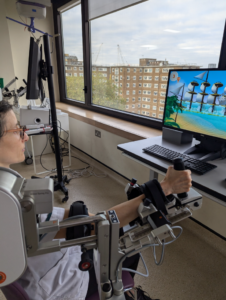Experience: The Wellington Hospital using the Armeo®Spring Pro
Hocoma
Eva Nunez, Clinical Specialist Occupational Therapist at The Wellington Hospital, has shared her clinical experience of using the Armeo®Spring Pro on the Hocoma Knowledge Platform.
The Wellington Hospital is a part of HCA Healthcare UK and have championed the use of rehabilitation technology for over a decade at their state-of-the-art rehabilitation centre. In 2024 The Wellington Hospital upgraded their Lokomat® and Armeo®Spring to the Lokomat®Pro Sensation and Armeo®Spring Pro.
We spoke with Eva Nunez about her experience with the new Armeo®Spring Pro and what impact the device has for patients. Thank you Eva for taking the time to speak with us!
How often do you use the Armeo®Spring Pro in your daily practice, and which patient groups do you use the Armeo®Spring Pro with?

I use the Armeo®Spring Pro in my daily clinical practice, within the context of a technology-based rehabilitation group called Hands On Tech.
The Hands-on Tech group is a semi-supervised 90-minute (time scheduled) 5 times a week, circuit-based upper limb group for adult inpatients following stroke. The Armeo®Spring Pro is used daily as one of the technology stations for the group participants.
Patients at any time post-stroke who are medically stable and able to follow 2-stage commands are considered. Patients are screened for secondary factors that may influence the use of the technology, including severe spasticity impacting on active and/or passive function that has not been managed and/or marked loss of the range of motion, painful shoulder awaiting further investigation and management, unstable medical conditions and absent movement throughout the upper limb. Patients would need a visible and unassisted active range of motion in shoulder flexion, in a seated position.
Patients in the group spent an average of 25-40 minutes using the Armeo®Spring Pro daily.
Which features or programs of the Armeo®Spring Pro do you use most often?
I primarily use the AROM and AMOVE assessment features and all the available games, depending on the patient’s capabilities.
I have some “favourite games” which I tend to gravitate towards. Based on clinical experience I have found these very enjoyable for patients and easy to understand even for patients with some cognitive and perceptual difficulties. Being able to reduce the visual detail of the games is also a feature that I often use with patients suffering from cognitive or perceptual challenges.
I particularly like the visual representation of the AMOVE results, as it shows clearly the patient’s progress with an increase of the workspace from one evaluation to the next.
What impact does the Armeo®Spring Pro have on patients, and what do they enjoy most from the device?
Patients often report that time passes quicker when they use the Armeo®Spring Pro versus a regular “exercise-based” session because they are distracted and motivated by the games.
During the “Hands on Tech” group, we encourage patients to beat their previous top scores, and this add an extra motivational factor. I have found that patients enjoy this competitive element.
Which advantages in clinical practice do you see in the Armeo®Spring Pro, compared to traditional therapy?
Research strongly suggests that high-dose intensive training represents an important factor in enhancing motor recovery after a brain injury. There are limitations to delivering this high-dose intensive training with the traditional one-to-one model (one therapist – one patient).
Research also suggests that there isn’t sufficient time dedicated to upper limb rehabilitation and that stroke survivors often find traditional exercises ” boring” or ” too difficult”.
The Armeo®Spring Pro can address these barriers. Some patients can be semi-supervised while working with the Armeo®Spring Pro and I have found the enjoyment and adherence to therapy higher with the Armeo®Spring Pro as compared to traditional therapy sessions.
How does the Armeo®Spring Pro compare with the Armeo®Spring?
I find the Armeo®Spring Pro easier and quicker to set up than the Armeo®Spring. I particularly like the alignment pin to mark the position of the acromion, which is very helpful for an accurate setup.
The Armeo®Spring Pro also fits more intimately to the patient’s arms, like a true exoskeleton and patients have reported that they feel it is easier to move their arm when using the Armeo®Spring Pro versus the Armeo®Spring thanks to the new arm weight support.
What are the benefits of using rehabilitation technology such as the Armeo®Spring Pro?
In summary, the Armeo®Spring Pro is a useful tool to promote high-dose upper limb therapy in a motivating and engaging way. It can be used across a wide range of patients, and it is highly customizable, allowing clinicians to create programs that adapt to patient’s individual needs. In my clinical experience, I have found that patients find this type of technology more appealing and motivating than traditional therapy sessions which is a great advantage to promote meaningful upper limb motor and functional recovery.
Read more on the Hocoma Knowledge Platform.
About Summit Medical and Scientific
Summit Medical and Scientific are passionate about the power of rehabilitation technology.
We represent clinical technology leaders Hocoma, Motek, Life Science Robotics and ddrobotec® to provide the total solution for rehabilitation in the UK. Our partners have developed innovative therapy devices using robotics, sensors and virtual reality for early and acute rehabilitation, gait and balance therapy, arm and hand therapy, body weight support and more. View all of our clinical solutions here.
Get in touch with Summit Medical and Scientific today to find out more about incorporating state-of-the-art rehabilitation technology into your practice. You can reach out via email at info@summitmedsci.co.uk or phone 01372 459863.
You can also follow us on Facebook, Instagram, Twitter and LinkedIn, and subscribe to our newsletter for the latest updates.

